Petrogenesis and Tectonic Setting of Ore-Associated Intrusive Rocks in the Baiyinnuoer Zn–Pb Deposit, Southern Great Xing’an Range (NE China): Constraints from Zircon U–Pb Dating, Geochemistry, and Sr–Nd–Pb Isotopes
Abstract
1. Introduction
2. Geological Setting
3. Samples and Analytical Methods
3.1. Samples
3.2. Analytical Technique
3.2.1. Whole-Rock Geochemical Analysis
3.2.2. Whole-Rock Sr–Nd Isotopic Analysis
3.2.3. Whole-Rock Pb Isotopic Analysis
3.2.4. Zircon U–Pb in Situ LA-ICP-MS Geochronology
4. Results
4.1. Whole-Rock Geochemistry
4.2. Whole-Rock Sr–Nd Isotopic Results
4.3. Whole-Rock Pb Isotopic Results
4.4. Zircon U–Pb Geochronology
5. Discussion
5.1. Age of Magmatism
5.2. Source and Petrogenesis of the Magma
5.2.1. Granodiorite and Granodiorite Porphyry
5.2.2. Diorite
5.3. Tectonic Implications
6. Conclusions
Supplementary Materials
Author Contributions
Funding
Acknowledgments
Conflicts of Interest
References
- Shu, Q.; Lai, Y.; Sun, Y.; Wang, C.; Meng, S. Ore genesis and hydrothermal evolution of the Baiyinnuo’er zinc–lead skarn deposit, Northeast China: Evidence from isotopes (S, Pb) and fluid inclusions. Econ. Geol. 2013, 108, 835–860. [Google Scholar] [CrossRef]
- Shu, Q.; Lai, Y.; Wang, C.; Xu, J.; Sun, Y. Geochronology, geochemistry and Sr–Nd–Hf isotopes of the Haisugou porphyry Mo deposit, northeast China, and their geological significance. J. Asian Earth Sci. 2014, 79, 777–791. [Google Scholar] [CrossRef]
- Zhai, D.; Liu, J.; Zhang, H.; Yao, M.; Wang, J.; Yang, Y. S–Pb isotopic geochemistry, U–Pb and Re–Os geochronology of the Huanggangliang Fe–Sn deposit, Inner Mongolia, NE China. Ore Geol. Rev. 2014, 59, 109–122. [Google Scholar] [CrossRef]
- Zhai, D.; Liu, J.; Zhang, H.; Tombros, S.; Zhang, A. A magmatic-hydrothermal origin for Ag–Pb–Zn vein formation at the Bianjiadayuan deposit, inner Mongolia, NE China: Evidences from fluid inclusion, stable (C–H–O) and noble gas isotope studies. Ore Geol. Rev. 2018, 101, 1–16. [Google Scholar] [CrossRef]
- Wu, F.-Y.; Lin, J.-Q.; Wilde, S.A.; Zhang, X.; Yang, J.-H. Nature and significance of the Early Cretaceous giant igneous event in eastern China. Earth Planet. Sci. Lett. 2005, 233, 103–119. [Google Scholar] [CrossRef]
- Wu, F.-Y.; Sun, D.-Y.; Ge, W.-C.; Zhang, Y.-B.; Grant, M.L.; Wilde, S.A.; Jahn, B.-M. Geochronology of the Phanerozoic granitoids in northeastern China. J. Asian Earth Sci. 2011, 41, 1–30. [Google Scholar] [CrossRef]
- Zeng, Q.D.; Liu, J.M.; Jia, C.S.; Wan, Z.M.; Yu, C.M.; Ye, J.; Liu, H.T. Sedimentary exhalative origin of the Baiyinnuoer zinc-lead deposit, Chifeng, Inner Mongolia: Geological and sulfur isotope evidence. J. Jilin Univ. (Earth Sci. Ed.) 2007, 37, 659–670. (In Chinese) [Google Scholar]
- Zeng, Q.; Liu, J.; Zhang, Z.; Jia, C.; Yu, C.; Ye, J.; Liu, H. Geology and lead-isotope study of the Baiyinnuoer Zn–Pb–Ag deposit, South Segment of the Da Hinggan Mountains, Northeastern China. Resour. Geol. 2009, 59, 170–180. [Google Scholar] [CrossRef]
- Xiao, W.J.; Windley, B.F.; Huang, B.C.; Han, C.M.; Yuan, C.; Chen, H.L.; Sun, M.; Sun, S.; Li, J.L. End-Permian to mid-Triassic termination of the accretionary processes of the southern Altaids: Implications for the geodynamic evolution, Phanerozoic continental growth, and metallogeny of Central Asia. Acta Diabetol. 2009, 98, 1189–1217. [Google Scholar]
- Zhang, J.-H.; Gao, S.; Ge, W.-C.; Wu, F.-Y.; Yang, J.-H.; Wilde, S.A.; Li, M. Geochronology of the Mesozoic volcanic rocks in the Great Xing’an Range, northeastern China: Implications for subduction-induced delamination. Chem. Geol. 2010, 276, 144–165. [Google Scholar] [CrossRef]
- Zhou, J.-B.; Wilde, S.A. The crustal accretion history and tectonic evolution of the NE China segment of the Central Asian Orogenic Belt. Gondwana Res. 2013, 23, 1365–1377. [Google Scholar] [CrossRef]
- Chen, Y.Q.; Li, C.S.; Zong, D.K. Mineral exploration type and productive exploration in Baiyinnuoer lead-zinc mine. Nonferrous Mines 2002, 31, 16–18. (In Chinese) [Google Scholar]
- Jiang, S.-H.; Chen, C.-L.; Bagas, L.; Liu, Y.; Han, N.; Kang, H.; Wang, Z.-H. Two mineralization events in the Baiyinnuoer Zn–Pb deposit in Inner Mongolia, China: Evidence from field observations, S–Pb isotopic compositions and U–Pb zircon ages. J. Asian Earth Sci. 2017, 144, 339–367. [Google Scholar] [CrossRef]
- Wan, Z.M.; Lan, R.W.; Yu, F. Law of alteration zoning, metallic zoning and discussion of production exploration in Baiyinnuoer Pb–Zn deposit, Chifeng. Miner. Deposits 2002, 21, 467–469. (In Chinese) [Google Scholar]
- Jiang, S.H.; Nie, F.J.; Bai, D.M.; Niu, S.Y.; Wang, B.D.; Liu, Y.F.; Liu, Y. Study on the lead isotopic features of the Baiyinnuoer Pb–Zn deposit in Inner Mongolia. J. Earth Sci. Environ. 2011, 33, 230–238. (In Chinese) [Google Scholar]
- Yi, J.; Wei, J.H.; Yao, C.L.; Zhao, S.Q.; Yu, C.L.; Li, Q.Y. Discovery and geological significance of the Triassic intrusive rocks in the Baiyinnuoer lead-zinc deposit, Inner Mongolia: Evidence from zircon U–Pb age. Geol. Sci. Technol. Inf. 2012, 31, 11–16. (In Chinese) [Google Scholar]
- Yang, F.; Wang, Y.; Na, F.C.; Fu, J.H.; Zhang, G.Y.; Sun, W.; Pang, X.J.; Chen, J.S.; Liu, M.; Li, B. Geological significance and metallogenic epoch of the Baiyinnuoer Pb–Zn deposit in Inner Mongolia: Constraints from geochemistry and chronology of intrusive rocks. J. Jilin Univ. (Earth Sci. Ed.) 2018, 48, 1696–1710. (In Chinese) [Google Scholar]
- Jahn, B.-M.; Wu, F.; Chen, B. Granitoids of the Central Asian Orogenic Belt and continental growth in the Phanerozoic. In Proceedings of the Fourth Hutton Symposium on the Origin of Granites and Related Rocks, Clermont-Ferrand, France, 20–25 September 2000; Volume 350, pp. 181–193. [Google Scholar]
- Jahn, B.M.; Capdevila, R.; Liu, D.; Vernov, A.; Badarch, G. Sources of Phanerozoic granitoids in the transect Bayanhongor–Ulan Baator, Mongolia: Geochemical and Nd isotopic evidence, and implications of Phanerozoic crustal growth. J. Asian Earth Sci. 2004, 23, 211–219. [Google Scholar] [CrossRef]
- Windley, B.F.; Alexeiev, D.; Xiao, W.J.; Kroner, A.; Badarch, G. Tectonicmodels for accretion of the Central Asian Orogenic Belt. J. Geol. Soc. Lond. 2007, 164, 31–47. [Google Scholar] [CrossRef]
- Xiao, W.; Sun, M.; Santosh, M. Continental reconstruction and metallogeny of the Circum-Junggar areas and termination of the southern Central Asian Orogenic Belt. Geosci. Front. 2015, 6, 137–140. [Google Scholar] [CrossRef]
- Xu, B.; Zhao, P.; Wang, Y.Y.; Liao, W.; Luo, Z.W.; Bao, Q.Z.; Zhou, Y.H. The pre-Devonian tectonic framework of Xing’an-Mongolia orogenic belt (XMOB) in North China. J. Asian Earth Sci. 2015, 97, 183–196. [Google Scholar] [CrossRef]
- Qi, J.P.; Chen, Y.J.; Pirajno, F. Geological characteristics and tectonic setting of the epithermal deposits in the Northeast China. J. Mineral. Petrol. 2005, 25, 47–59. (In Chinese) [Google Scholar]
- Li, J.-Y. Permian geodynamic setting of Northeast China and adjacent regions: Closure of the Paleo-Asian Ocean and subduction of the Paleo-Pacific Plate. J. Asian Earth Sci. 2006, 26, 207–224. [Google Scholar] [CrossRef]
- Chen, Y.-J.; Zhang, C.; Wang, P.; Pirajno, F.; Li, N. The Mo deposits of Northeast China: A powerful indicator of tectonic settings and associated evolutionary trends. Ore Geol. Rev. 2017, 81, 602–640. [Google Scholar] [CrossRef]
- Chen, Y.J.; Zhai, M.G.; Jiang, S.Y. Significant achievements and open issues in study of orogenesis and metallogenesis surrounding the North China continent. Acta Petrol. 2009, 25, 2695–2726. (In Chinese) [Google Scholar]
- Ouyang, H.; Mao, J.; Zhou, Z.; Su, H. Late Mesozoic metallogeny and intracontinental magmatism, southern Great Xing’an Range, northeastern China. Gondwana Res. 2015, 27, 1153–1172. [Google Scholar] [CrossRef]
- Zhao, Y.M.; Zhang, D.Q. Metallogeny and Prospective Evaluation of Copper-Polymetallic Deposits in the Da Hinggan Mountains and Its Adjacent Regions; Seismological Press: Beijing, China, 1997; p. 318. (In Chinese) [Google Scholar]
- Niu, S.Y.; Sun, A.Q.; Guo, L.J.; Wang, B.D.; Hu, H.B.; Jian, M. Ore-control structures and prospencting for the Baiyinnuoer Pb–Zn deposit in the Da Hinggan range. Geotecton. Metallog. 2008, 32, 72–80. (In Chinese) [Google Scholar]
- Wang, X.; Xu, D.; Lv, X.; Wei, W.; Mei, W.; Fan, X.; Sun, B. Origin of the Haobugao skarn Fe–Zn polymetallic deposit, Southern Great xing’an range, NE China: Geochronological, geochemical, and Sr-Nd-Pb isotopic constraints. Ore Geol. Rev. 2018, 94, 58–72. [Google Scholar] [CrossRef]
- Zhai, D.; Williams-Jones, A.E.; Liu, J.; Selby, D.; Li, C.; Huang, X.-W.; Qi, L.; Guo, D. Evaluating the use of the molybdenite Re–Os chronometer in dating gold mineralization: Evidence from the Haigou Deposit, Northeastern China. Econ. Geol. 2019, 114, 897–915. [Google Scholar] [CrossRef]
- Chen, B.; Jahn, B. Geochemical and isotopic studies of the sedimentary and granitic rocks of the Altai Orogen of NW China and their tectonic implications. Geol. Mag. 2001, 139, 1–13. [Google Scholar] [CrossRef]
- Li, W.; Zhong, R.; Xu, C.; Song, B.; Qu, W. U–Pb and Re–Os geochronology of the Bainaimiao Cu–Mo–Au deposit, on the northern margin of the North China Craton, Central Asia Orogenic Belt: Implications for ore genesis and geodynamic setting. Ore Geol. Rev. 2012, 48, 139–150. [Google Scholar] [CrossRef]
- Wang, F.; Zhou, X.-H.; Zhang, L.-C.; Ying, J.-F.; Zhang, Y.-T.; Wu, F.-Y.; Zhu, R.-X. Late Mesozoic volcanism in the Great Xing’an Range (NE China): Timing and implications for the dynamic setting of NE Asia. Earth Planet. Sci. Lett. 2006, 251, 179–198. [Google Scholar] [CrossRef]
- Wei, C.-S.; Zhao, Z.-F.; Spicuzza, M.J. Zircon oxygen isotopic constraint on the sources of late Mesozoic A-type granites in eastern China. Chem. Geol. 2008, 250, 1–15. [Google Scholar] [CrossRef]
- Wang, S.M.; Yan, M.H. GB/T 14506.28-2010. Methods for Chemical Analysis of Silicate Rocks-PART 28: Determination of 16 Major and Minor Elements Content; Standards Press of China: Beijing, China, 2010. (In Chinese) [Google Scholar]
- Ludwig, K.R. ISOPLOT 3.00: A Geochronological Toolkit for Microsoft Excel; Special Publication No. 4; Berkeley Geochronology Center: Berkeley, CA, USA, 2003. [Google Scholar]
- Middlemost, E.A.K. Magmas and Magmatic Rocks; Longman: London, UK, 1985; p. 266. [Google Scholar]
- Bas, M.J.L.; Maitre, R.W.L.; Streckeisen, A.; Zanettin, B. A chemical classification of volcanic rocks based on the total alkali-silica diagram. J. Pet. 1986, 27, 745–750. [Google Scholar] [CrossRef]
- Maniar, P.D.; Piccoli, P.M. Tectonic discrimination of granitoids. GSA Bull. 1989, 101, 635–643. [Google Scholar] [CrossRef]
- Sun, S.-S.; McDonough, W.F. Chemical and isotopic systematics of oceanic basalts: Implications for mantle composition and processes. In Magmatism in the Ocean Basins, 42; Saunders, A.D., Norry, M.J., Eds.; Special Publications; Geological Society: London, UK, 1989; pp. 313–345. [Google Scholar]
- Wu, F.-Y.; Jahn, B.M.; Wilde, S.A.; Lo, C.H.; Yui, T.F.; Lin, Q.; Ge, W.C.; Sun, D.Y. Highly fractionated I-type granites in NE China (II): Isotopic geochemistry and implications for crustal growth in the Phanerozoic. Lithos 2003, 67, 191–204. [Google Scholar] [CrossRef]
- Zartman, R.E.; Doe, B.R. Plumbotectonics: The model. Tectonophysics 1981, 75, 135–162. [Google Scholar] [CrossRef]
- Hoskin, P.W.; Ireland, T.R. Rare earth element chemistry of zircon and its use as a provenance indicator. Geol. 2000, 28, 627. [Google Scholar] [CrossRef]
- Guo, Z.J.; Zhou, Z.H.; Li, G.T.; Li, J.W.; Wu, X.L.; Ou, Y.H.G.; Wang, A.S.; Xiang, A.P.; Dong, X.Z. SHRIMP U–Pb zircon dating and petrogeochemistral characteristics of the intermediate-acid intrusive rocks in the Aoergai copper deposit of Inner Mongolia. Geol. China 2012, 6, 1486–1500. (In Chinese) [Google Scholar]
- Kang, Y.; She, H.; Lai, Y.; Wang, Z.; Li, J.; Zhang, Z.; Xiang, A.; Jiang, Z. Evolution of Middle-Late Triassic granitic intrusions from the Badaguan Cu-Mo deposit, Inner Mongolia: Constraints from zircon U–Pb dating, geochemistry and Hf isotopes. Ore Geol. Rev. 2018, 95, 195–215. [Google Scholar] [CrossRef]
- Barbarin, B. A review of the relationships between granitoid types, their origins and their geodynamic environments. Lithos 1999, 46, 605–626. [Google Scholar] [CrossRef]
- Chappell, B.W.; White, A.J.R. Two contrasting granite types. Pac. Geol. 1974, 8, 173–174. [Google Scholar]
- Loiselle, M.C.; Wones, D.R. Characteristics of anorogenic granites. Geol. Soc. Am. Abstr. Programs 1979, 11, 468. [Google Scholar]
- Chappell, B.W.; White, A.J.R. Two contrasting granite types: 25 years later. Aust. J. Earth Sci. 2001, 48, 489–499. [Google Scholar] [CrossRef]
- Whalen, J.B.; Currie, K.L.; Chappell, B.W. A-type granites: Geochemical characteristics, discrimination and petrogenesis. Contrib. Miner. Pet. 1987, 95, 407–419. [Google Scholar] [CrossRef]
- Chappell, B.W.; White, A.J.R. I- and S-type granites in the Lachlan Fold Belt. Trans. R. Soc. Edinb. Earth Sci. 1992, 272, 1–26. [Google Scholar]
- Chappell, B. Aluminium saturation in I- and S-type granites and the characterization of fractionated haplogranites. Lithos 1999, 46, 535–551. [Google Scholar] [CrossRef]
- Douce, A.E.P.; Harris, N. Experimental Constraints on Himalayan Anatexis. J. Pet. 1998, 39, 689–710. [Google Scholar] [CrossRef]
- Barbarin, B. Mafic magmatic enclaves and mafic rocks associated with some granitoids of the central Sierra Nevada batholith, California: Nature, origin, and relations with the hosts. Lithos 2005, 80, 155–177. [Google Scholar] [CrossRef]
- Grove, T.L.; Elkins-Tanton, L.T.; Parman, S.W.; Chatterjee, N.; Gaetani, G.A. Fractional crystallization and mantle-melting controls on calc-alkaline differentiation trends. Contrib. Miner. Pet. 2003, 145, 515–533. [Google Scholar] [CrossRef]
- Jagoutz, O.; Schmidt, M. The formation and bulk composition of modern juvenile continental crust: The Kohistan arc. Chem. Geol. 2012, 298, 79–96. [Google Scholar] [CrossRef]
- Rapp, R.; Shimizu, N.; Norman, M.; Applegate, G. Reaction between slab-derived melts and peridotite in the mantle wedge: Experimental constraints at 3.8 GPa. Chem. Geol. 1999, 160, 335–356. [Google Scholar] [CrossRef]
- Martin, H.; Smithies, R.H.; Moyen, J.F.; Champion, D. An overview of adakite, tonalite–trondhjemite–granodiorite (TTG), and sanukitoid: Relationships and some implications for crust evolution. Lithos 2005, 79, 1–24. [Google Scholar] [CrossRef]
- Petford, N.; Atherton, M. Na-rich Partial Melts from Newly Underplated Basaltic Crust: The Cordillera Blanca Batholith, Peru. J. Pet. 1996, 37, 1491–1521. [Google Scholar] [CrossRef]
- Taylor, S.R.; Mclennan, S.M. The Continental Crust: Its Composition and Evolution; Blackwell: Oxford, UK, 1985. [Google Scholar]
- Ersoy, Y.; HelvacI, C. FC-AFC-FCA and mixing modeler: A Microsoft Excel(c) spreadsheet program for modeling geochemical differentiation of magma by crystal fractionation, crustal assimilation and mixing. Comput. Geosci. 2010, 36, 383–390. [Google Scholar] [CrossRef]
- Wang, W.; Liu, S.; Santosh, M.; Wang, G.; Bai, X.; Guo, R. Neoarchean intra-oceanic arc system in the Western Liaoning Province: Implications for Early Precambrian crustal evolution in the Eastern Block of the North China Craton. Earth Sci. Rev. 2015, 150, 329–364. [Google Scholar] [CrossRef]
- Khain, E.; Bibikova, E.; Kröner, A.; Zhuravlev, D.; Sklyarov, E.; Fedotova, A.; Kravchenko-Berezhnoy, I. The most ancient ophiolite of the Central Asian fold belt: U–Pb and Pb–Pb zircon ages for the Dunzhugur Complex, Eastern Sayan, Siberia, and geodynamic implications. Earth Planet. Sci. Lett. 2002, 199, 311–325. [Google Scholar] [CrossRef]
- Tang, K. Tectonic development of Paleozoic fold belts at the north margin of the Sino-Korean craton. Tectonics 1990, 9, 249–260. [Google Scholar] [CrossRef]
- Tang, K.; Yan, Z. Regional metamorphism and tectonic evolution of the Inner Mongolian suture zone. J. Metamorph. Geol. 1993, 11, 511–522. [Google Scholar]
- Shi, Y.; Liu, Z.; Liu, Y.; Shi, S.; Wei, M.; Yang, J.; Gao, T. Late Paleozoic–Early Mesozoic southward subduction-closure of the Paleo-Asian Ocean: Proof from geochemistry and geochronology of Early Permian–Late Triassic felsic intrusive rocks from North Liaoning, NE China. Lithos 2019, 346, 1–24. [Google Scholar] [CrossRef]
- Liu, Y.; Li, W.; Feng, Z.; Wen, Q.; Neubauer, F.; Liang, C. A review of the Paleozoic tectonics in the eastern part of Central Asian Orogenic Belt. Gondwana Res. 2017, 43, 123–148. [Google Scholar] [CrossRef]
- Sun, D.-Y.; Gou, J.; Wang, T.-H.; Ren, Y.-S.; Liu, Y.-J.; Guo, H.-Y.; Liu, X.-M.; Hu, Z.-C. Geochronological and geochemical constraints on the Erguna massif basement, NE China—Subduction history of the Mongol–Okhotsk oceanic crust. Int. Geol. Rev. 2013, 55, 1801–1816. [Google Scholar] [CrossRef]
- Zhang, X.; Yuan, L.; Xue, F.; Yan, X.; Mao, Q. Early Permian A-type granites from central Inner Mongolia, North China: Magmatic tracer of post-collisional tectonics and oceanic crustal recycling. Gondwana Res. 2015, 28, 311–327. [Google Scholar] [CrossRef]
- Jian, P.; Liu, D.; Kröner, A.; Windley, B.F.; Shi, Y.; Zhang, W.; Zhang, F.; Miao, L.; Zhang, L.; Tomurhuu, D. Evolution of a Permian intraoceanic arc–trench system in the Solonker suture zone, Central Asian Orogenic Belt, China and Mongolia. Lithos 2010, 118, 169–190. [Google Scholar] [CrossRef]
- Pearce, J.A.; Harris, N.B.W.; Tindle, A.G. Trace Element Discrimination Diagrams for the Tectonic Interpretation of Granitic Rocks. J. Pet. 1984, 25, 956–983. [Google Scholar] [CrossRef]
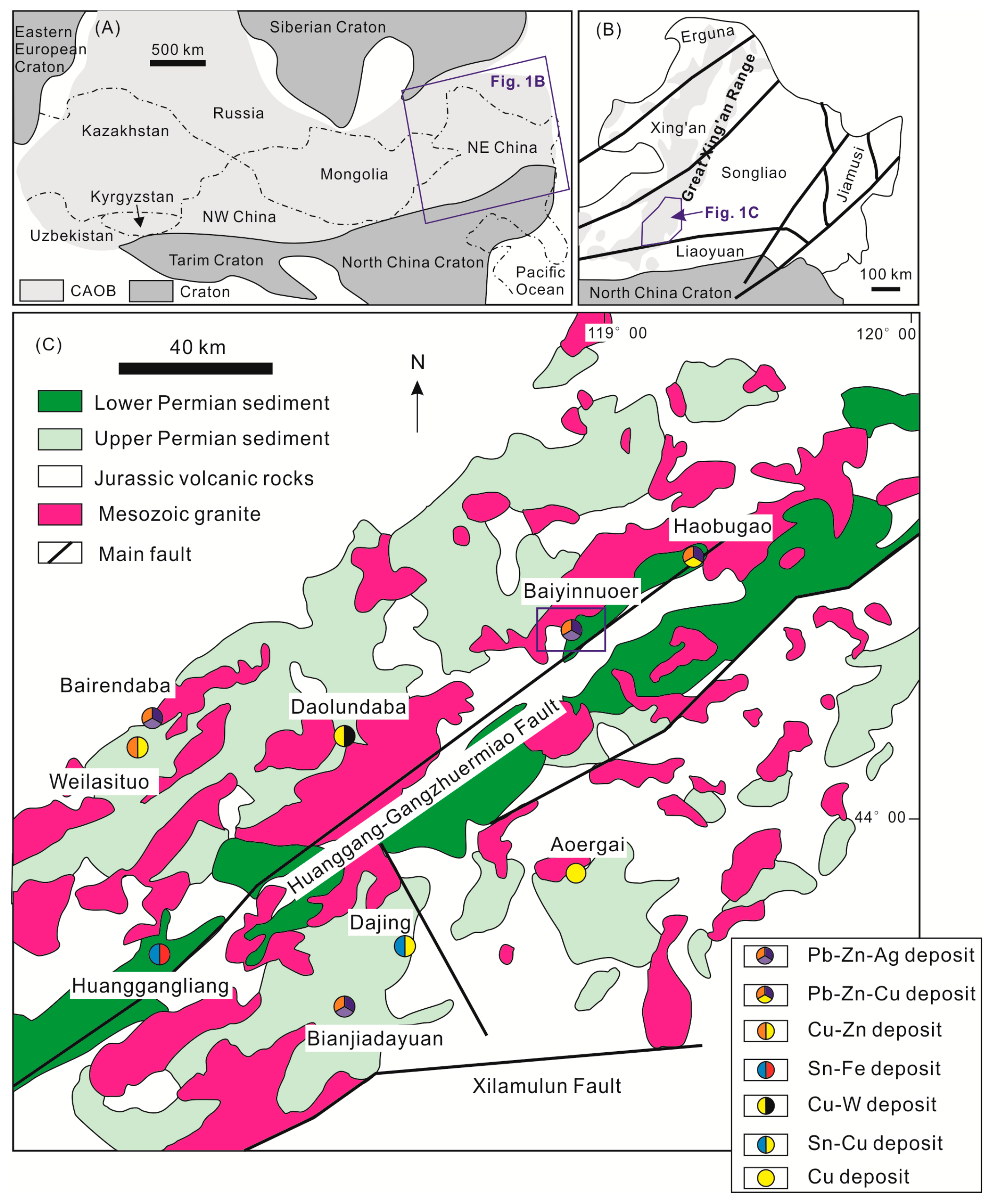
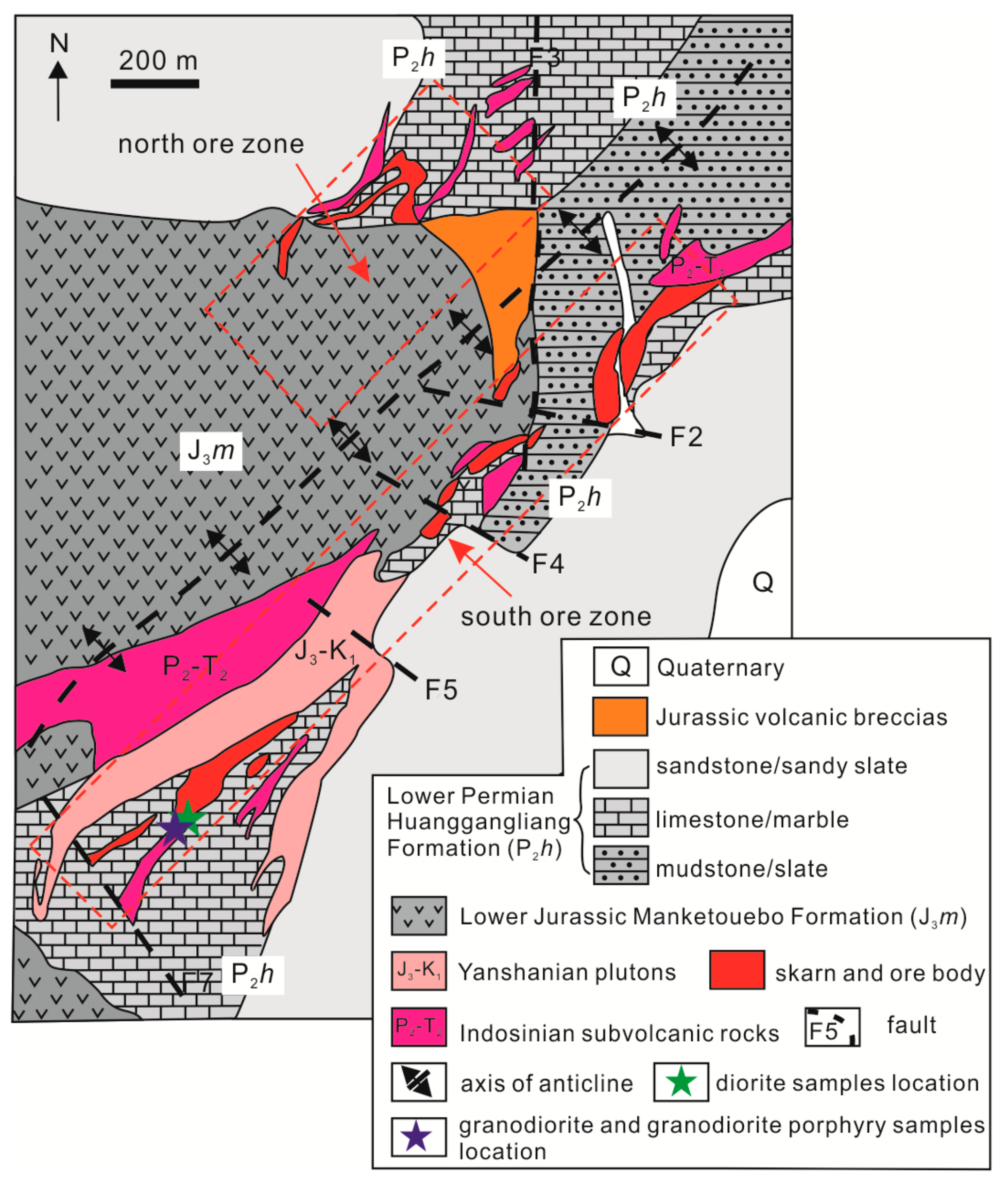
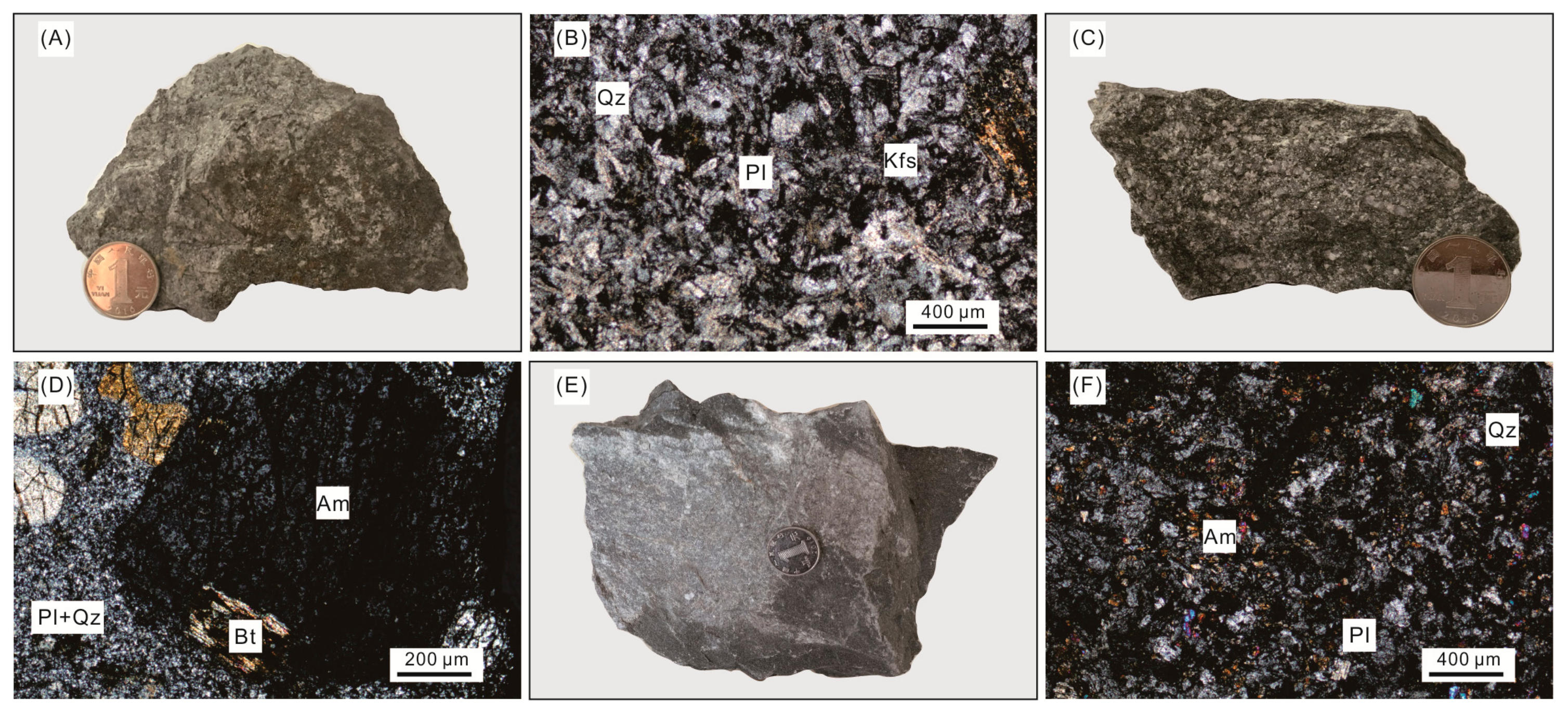

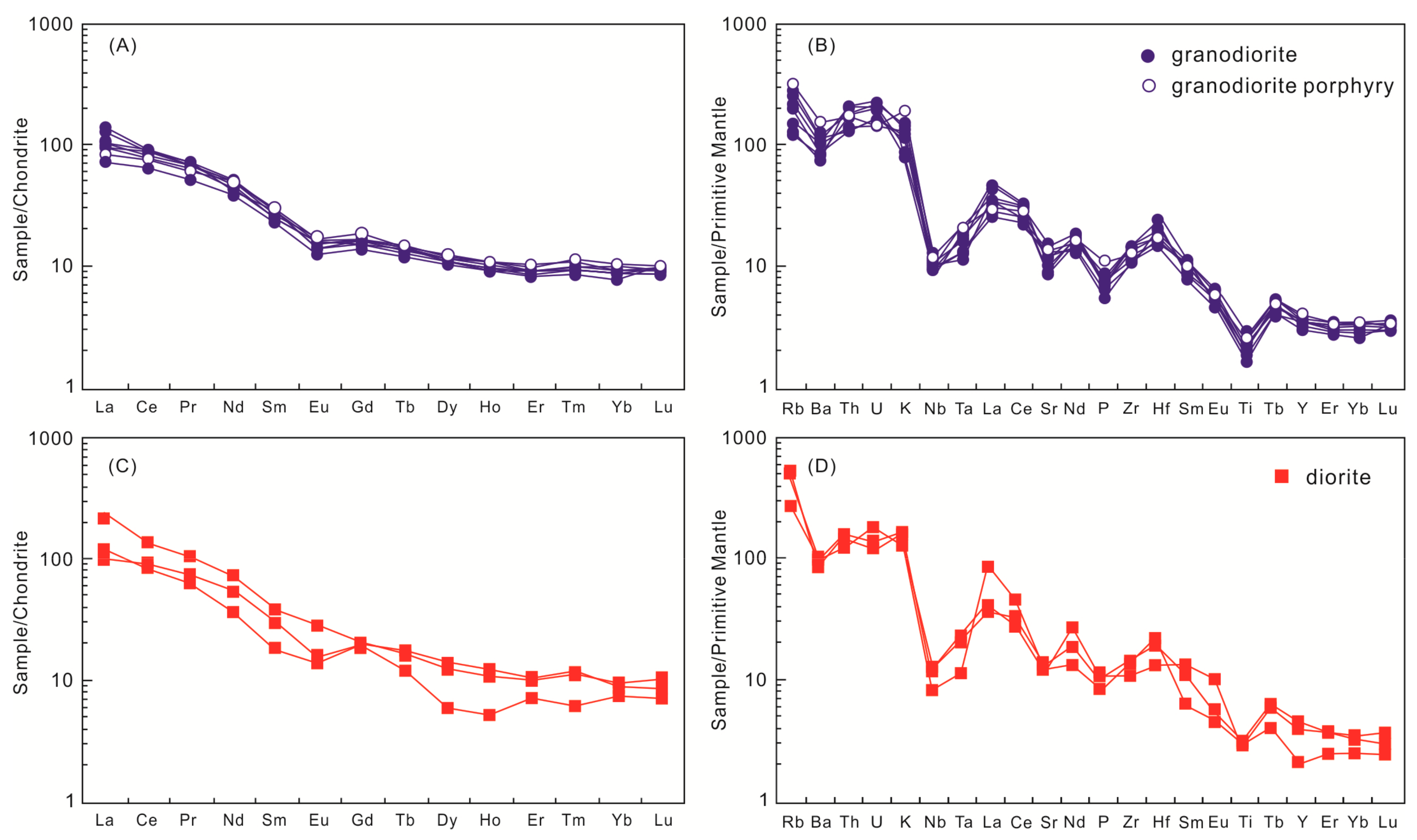
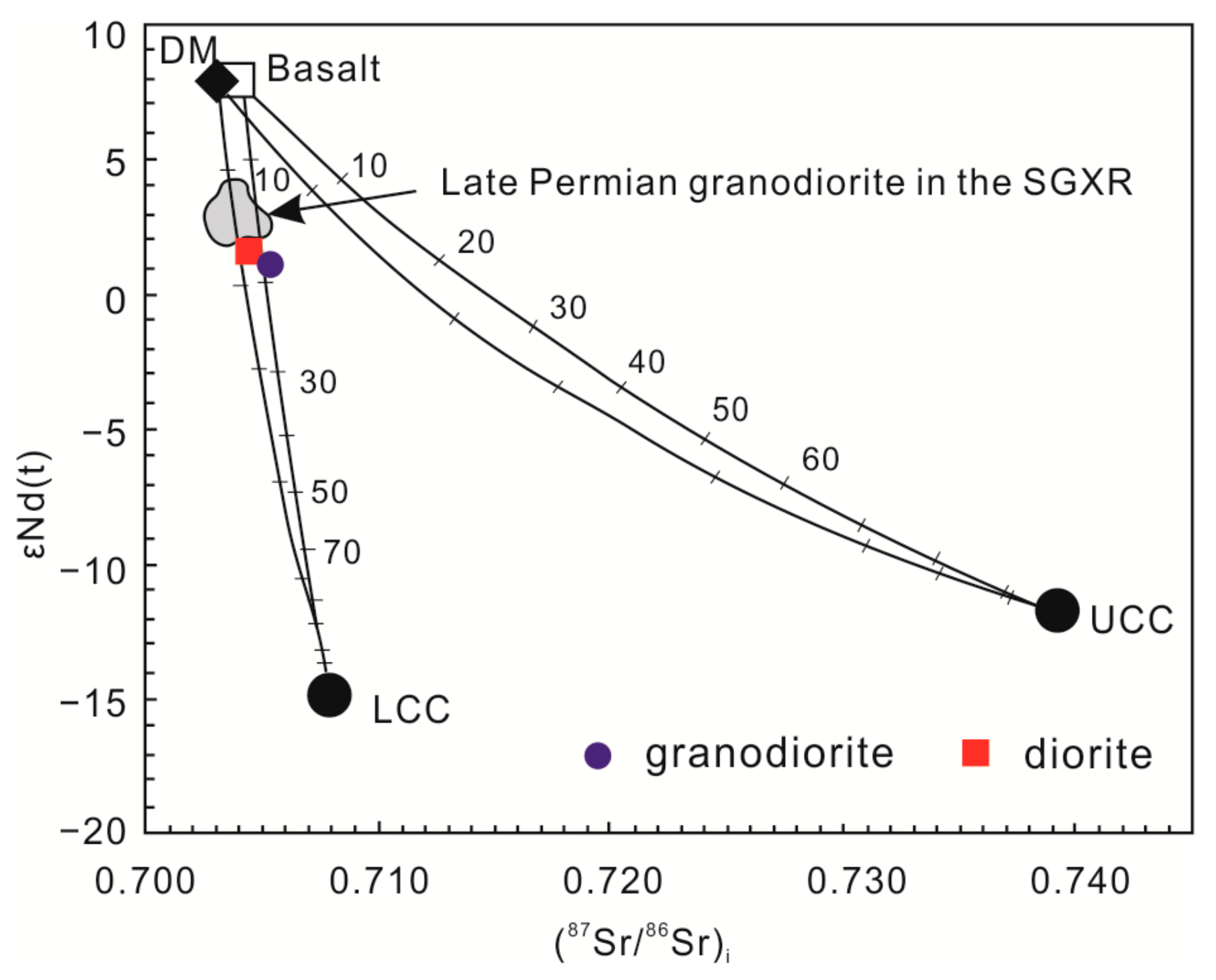
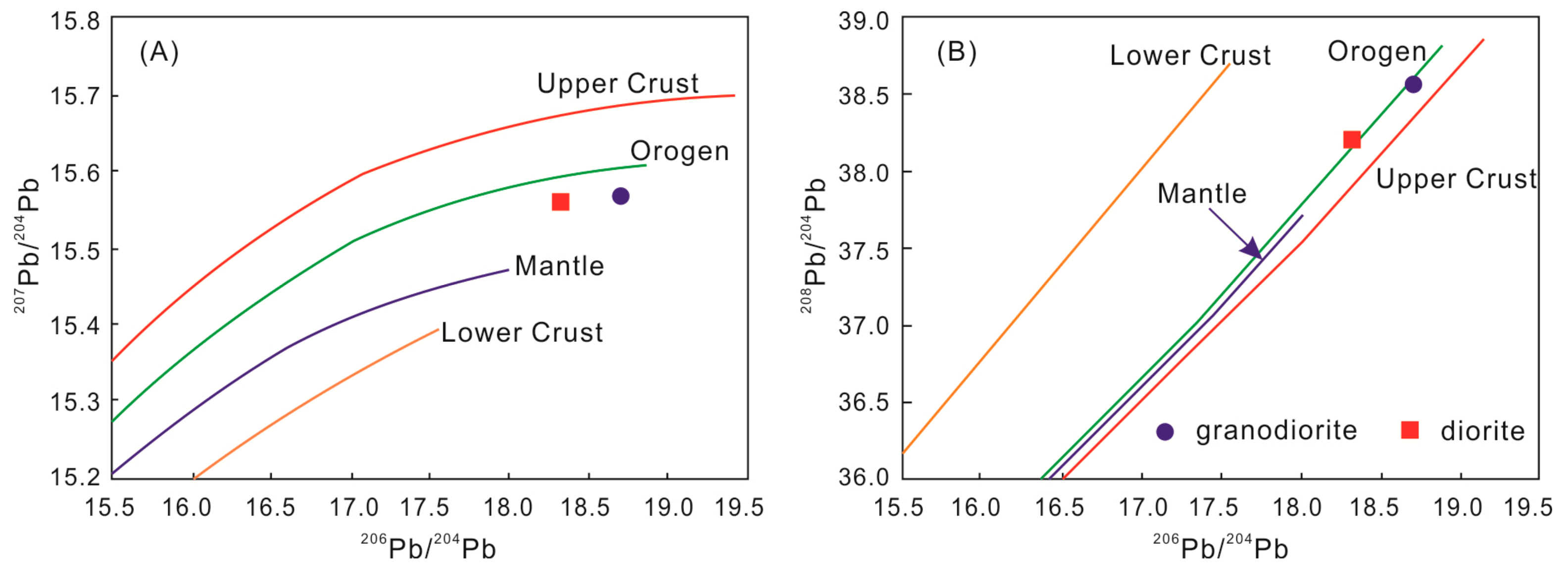
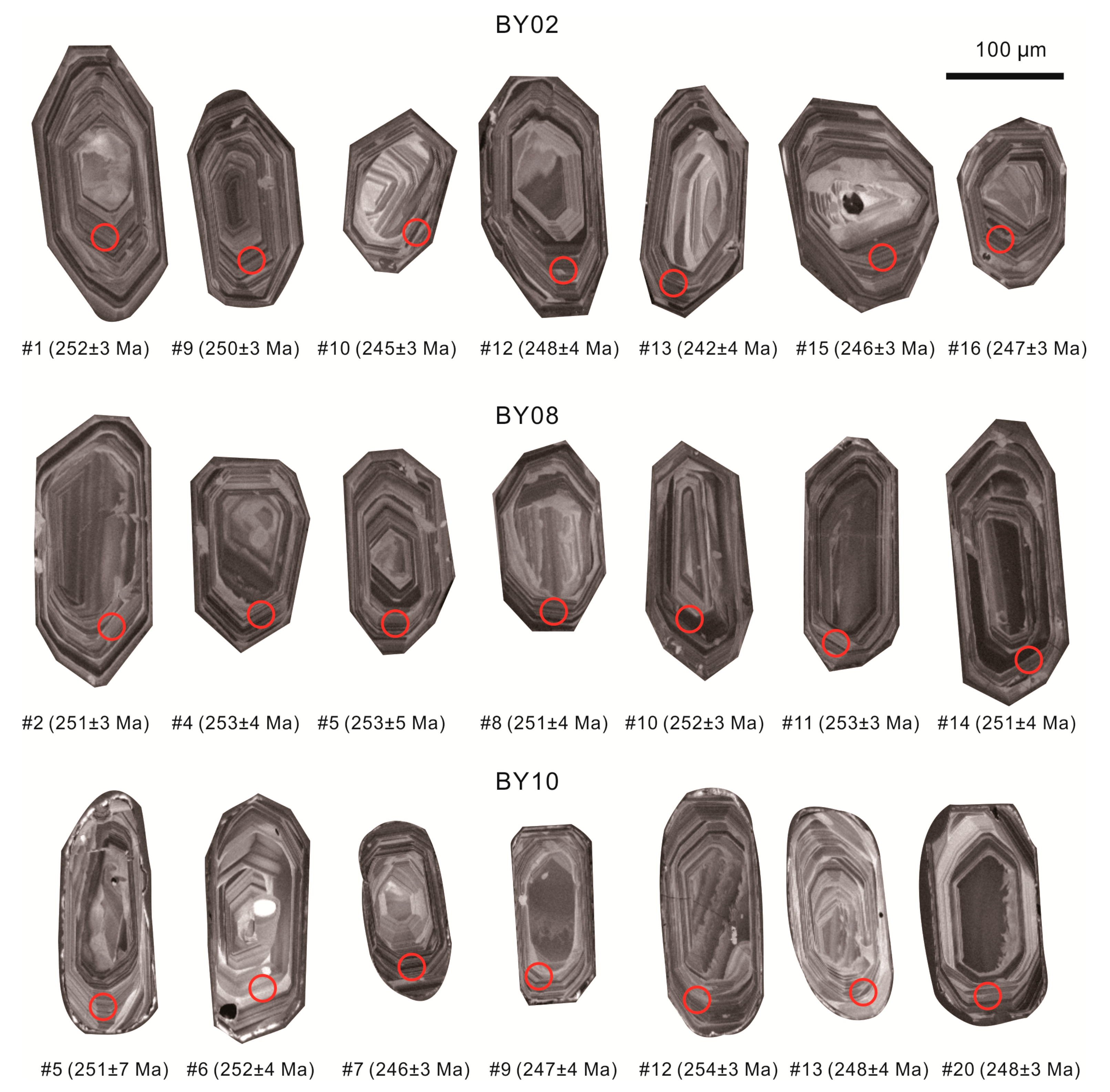
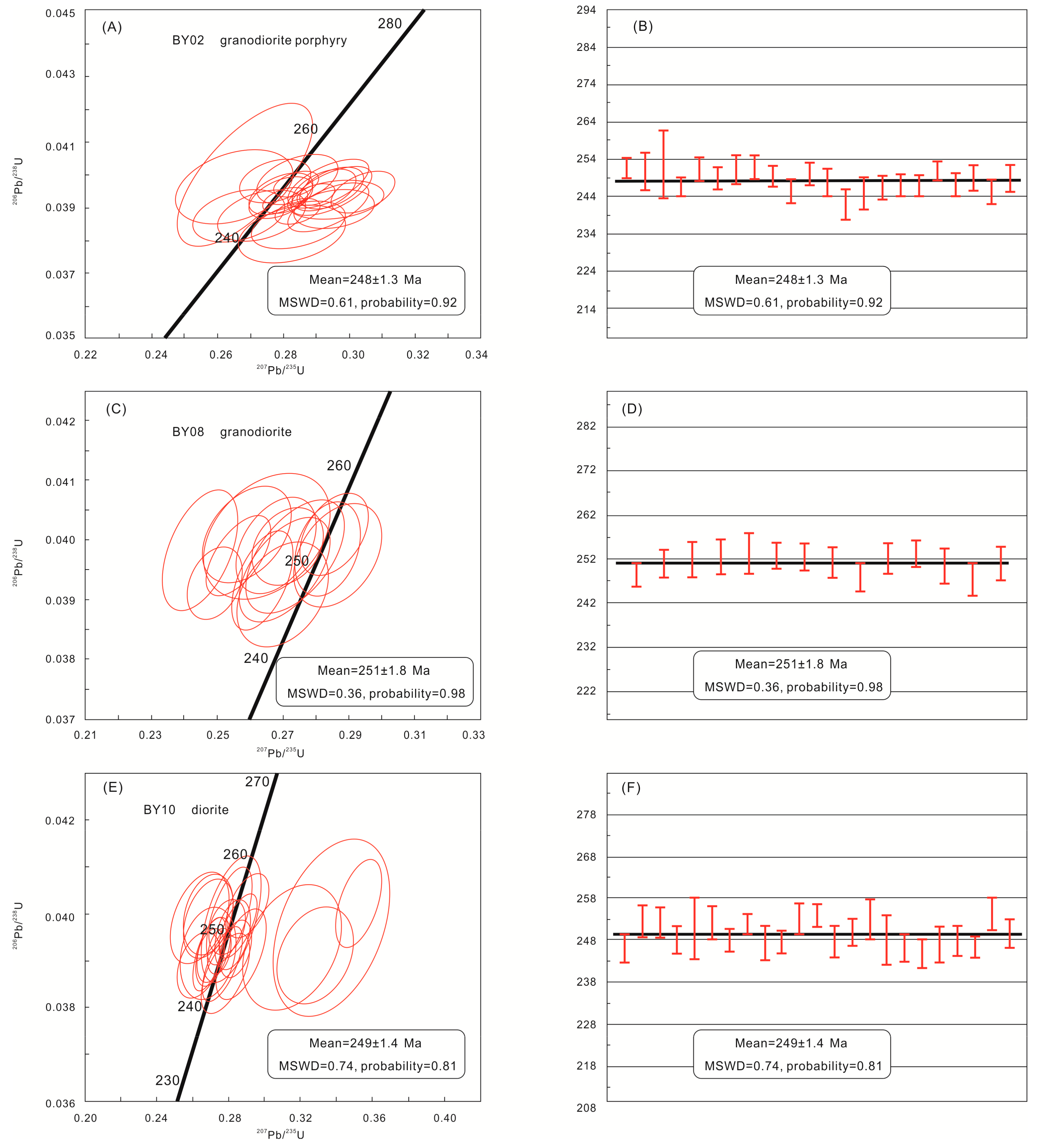
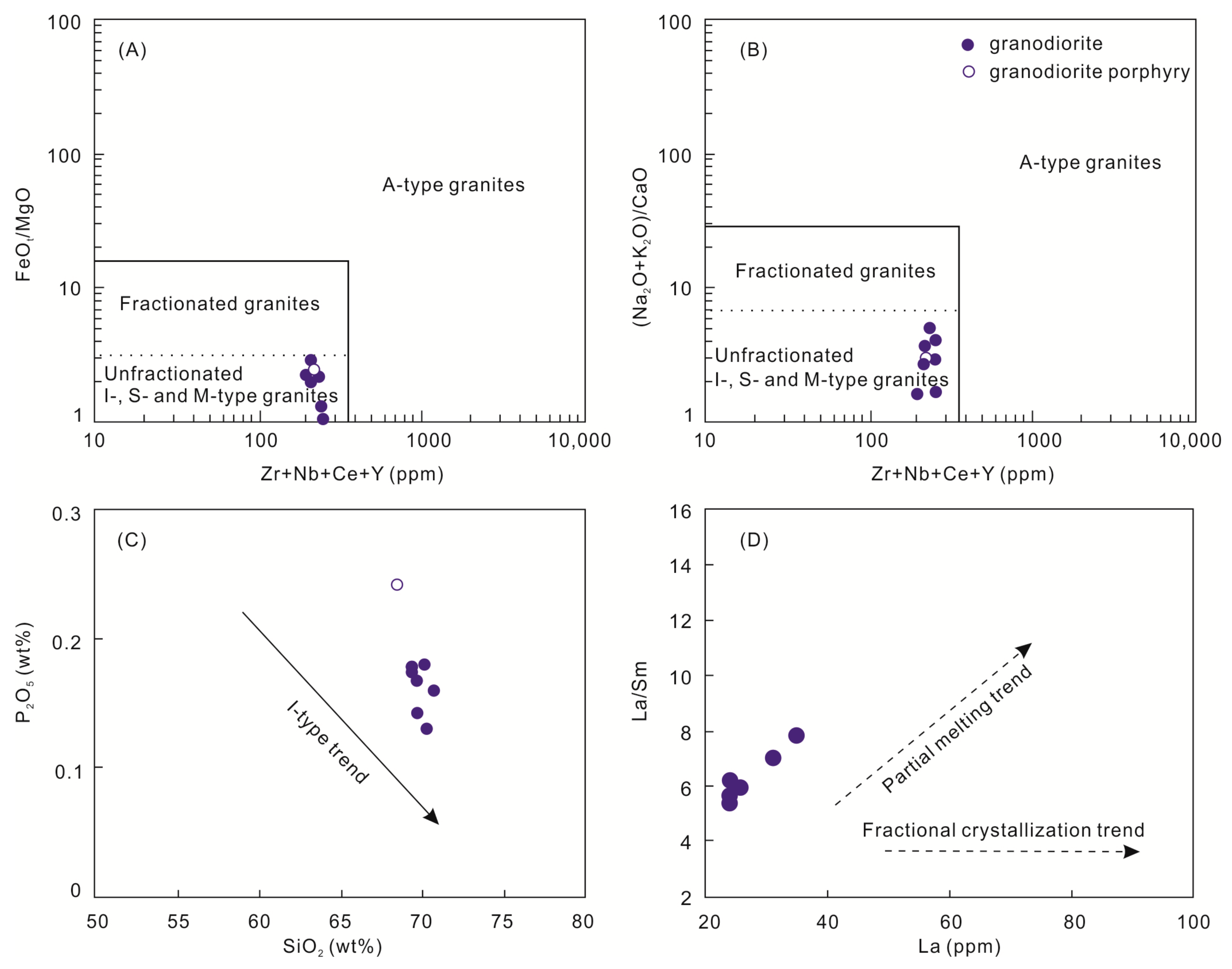
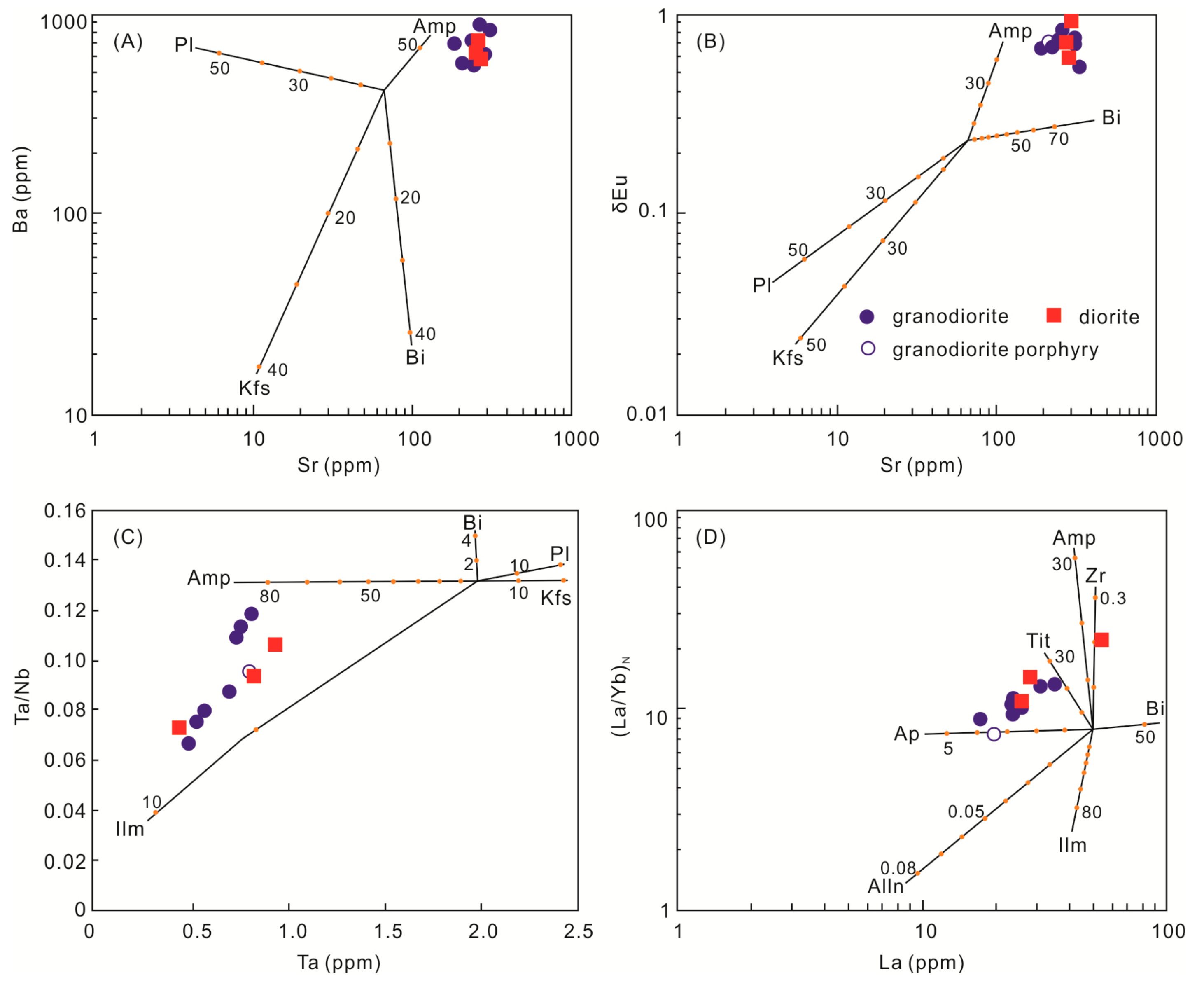
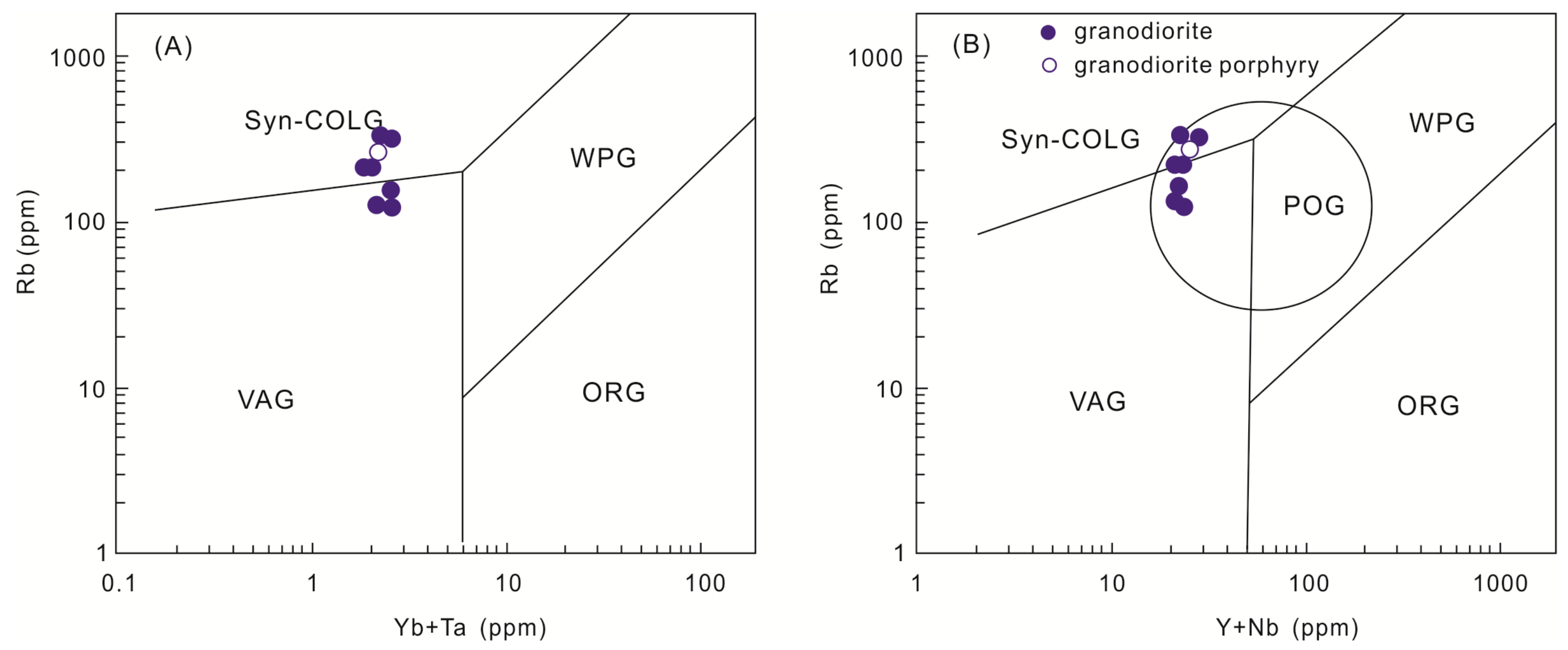
© 2019 by the authors. Licensee MDPI, Basel, Switzerland. This article is an open access article distributed under the terms and conditions of the Creative Commons Attribution (CC BY) license (http://creativecommons.org/licenses/by/4.0/).
Share and Cite
Zhao, Q.; Xiao, R.; Zhang, D.; Wang, J.; Zhang, Y.; Li, P. Petrogenesis and Tectonic Setting of Ore-Associated Intrusive Rocks in the Baiyinnuoer Zn–Pb Deposit, Southern Great Xing’an Range (NE China): Constraints from Zircon U–Pb Dating, Geochemistry, and Sr–Nd–Pb Isotopes. Minerals 2020, 10, 19. https://doi.org/10.3390/min10010019
Zhao Q, Xiao R, Zhang D, Wang J, Zhang Y, Li P. Petrogenesis and Tectonic Setting of Ore-Associated Intrusive Rocks in the Baiyinnuoer Zn–Pb Deposit, Southern Great Xing’an Range (NE China): Constraints from Zircon U–Pb Dating, Geochemistry, and Sr–Nd–Pb Isotopes. Minerals. 2020; 10(1):19. https://doi.org/10.3390/min10010019
Chicago/Turabian StyleZhao, Qing, Rongge Xiao, Dehui Zhang, Jianping Wang, Yanfei Zhang, and Panpan Li. 2020. "Petrogenesis and Tectonic Setting of Ore-Associated Intrusive Rocks in the Baiyinnuoer Zn–Pb Deposit, Southern Great Xing’an Range (NE China): Constraints from Zircon U–Pb Dating, Geochemistry, and Sr–Nd–Pb Isotopes" Minerals 10, no. 1: 19. https://doi.org/10.3390/min10010019
APA StyleZhao, Q., Xiao, R., Zhang, D., Wang, J., Zhang, Y., & Li, P. (2020). Petrogenesis and Tectonic Setting of Ore-Associated Intrusive Rocks in the Baiyinnuoer Zn–Pb Deposit, Southern Great Xing’an Range (NE China): Constraints from Zircon U–Pb Dating, Geochemistry, and Sr–Nd–Pb Isotopes. Minerals, 10(1), 19. https://doi.org/10.3390/min10010019




